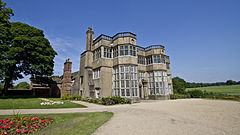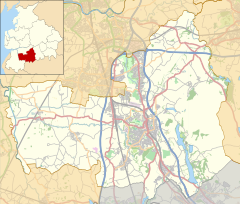Astley Hall (Chorley)
| Astley Hall | |
|---|---|
 |
|
|
Location in the Borough of Chorley
|
|
| Alternative names | Astley Hall Museum and Art Gallery |
| General information | |
| Type | Country house |
| Architectural style | Renaissance |
| Town or city | Chorley, Lancashire |
| Country | England |
| Coordinates | 53°39′34″N 2°38′43″W / 53.6595°N 2.6453°WCoordinates: 53°39′34″N 2°38′43″W / 53.6595°N 2.6453°W |
| Construction started | c. 1570 |
| Completed | 1630, 1653 or 1666 |
| Renovated | 1949 |
| Owner | Chorley Borough Council |
| Website | |
| www |
|
|
Listed Building – Grade I
|
|
| Designated | 21 December 1966 |
| Reference no. | 1362068 |
Astley Hall is a country house in Chorley, Lancashire, England. The hall is now owned by the town and is known as Astley Hall Museum and Art Gallery. The extensive landscaped grounds are now Chorley's Astley Park.
The site was acquired in the 15th century by the Charnock family from the Knights of St. John of Jerusalem. The Charnocks built the original timber-framed house, around a small courtyard, about 1575-1600. In 1665, Margaret Charnock married Richard Brooke of Mere in Cheshire (son of Sir Peter Brooke), and they built the present grand but asymmetrical front range of brick with a pair of vast mullion and transomed bay windows. This front has a doorway with distinctly rustic Ionic columns, remarkable at such a late date.
The interior is notable for the staggering mid-17th century plasterwork in the ceilings of the Great Hall and drawing room, which have heavy wreaths and disporting cherubs. The ceilings are barbaric in their excesses, and the figures are relatively poorly modelled, although the undercutting is breathtaking. Not all the moulding is of stucco: there are elements of lead and leather too. The staircase is of the same period with a coarse but vigorously carved acanthus scroll balustrade and square newels with vases of flowers on top.
The lower parts of the hall are panelled with inset paintings of a curious selection of modern worthies, including Protestants such as Elizabeth I and William the Silent; Catholics such as Philip II and Ambrogio Spinola; the explorers Christopher Columbus and Ferdinand Magellan, and Muhammadans such as Bajazet and Mohammed II, Sultans of Turkey; it is thought this scheme might be rather earlier than the other work and date from the time of MP Thomas Charnock, who died in 1648. The entire width of the house on the top floor is occupied by a long gallery which contains the finest shovelboard table in existence, 23.5 feet (7.2 m) long.
...
Wikipedia

